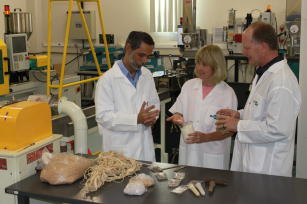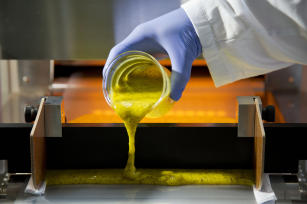Researchers create magnetic nanopigments addressed to different markets
Researchers create magnetic nanopigments addressed to different markets
Scientists have just developed pigments with unusual applications, ranging from creating new nail polish colors, marking livestock to others in a variety of areas. These are the nanopigments developed at the Nanotechnology Laboratory (LNANO) of Embrapa Genetic Resources and Biotechnology (DF), in partnership with the company TecSinapse, and that are already available to the industrial sector. The product will be presented at the 4º Workshop Nichos de Mercado para o Setor Agroindustrial [4th Workshop on Niche Market for the Agroindustrial Sector], on November 7 and 8, in Fortaleza (CE), Brazil – see table for further information at the end of the article.
The development of this technology is in accordance with the principles of green chemistry, which is concerned about the environment. The production process of the magnetic nanopigments takes place through eco-friendly routes, that is, with less waste and toxicity, during which it is possible to perform color modulation of the magnetic nanoparticles, giving them new properties.
"The use of this material may occur in several sectors, especially in agriculture, but also in biomedicine, pharmacology and even in the textile and cosmetics industry," Embrapa researcher Luciano Paulino, who coordinates LNANO, says.
Unlike a traditional pigment in which color is the most striking feature, magnetic nanopigments, in addition to color, respond to the application of an external magnetic field by the use of a magnet, which gives them new characteristics. In addition, Embrapa scientist says that new properties, such as antimicrobial action, can be incorporated into magnetic nanopigments to further expansion of the product's multifunctionality.
This technology can be useful in biology for the separation and labeling of organisms, organs, tissues, cells, and molecules. In medicine, it can help diagnosis and treatment of diseases and infections. In the field of pharmacology, it will be able to promote transport and controlled release of active ingredients. In cosmetology, it will allow the creation of products with new effects and colors. There are potential applications in various industrial sectors, such as in the manufacture of catalysts and sensors, or in the environmental area, in the remediation of contaminated effluents by chemical and biological agents. In agriculture, it can help in the control of pests and agricultural pathogens and even mark animals in order to track herds.
Until the development of this research, formalized in 2017 with a partnership agreement between Embrapa and TecSinapse, only magnetic nanomaterials in colors ranging from reddish brown to black could be found in the market. This is because the synthesis of magnetic nanoparticles was quite limited in the final coloring of the products. This work allowed the widening of the range of available colors, which now can be green, blue, yellow and wine color, for example.
"Once you change the color, it is possible to gain new properties that can be used to mark cells, absorb paint, and mark livestock. There are also opportunities for application in the textile and veterinary industries", TecSinapse researcher Cinthia Bonatto explains the different possibilities for using the technology.
Use of technology in livestock
Researcher Luciano Paulino comments that small producers generally do not have access to modern technologies for identifying herds, such as chips and earrings. This public still uses the process of marking cattle with branding iron. Therefore, this identification of animals is one of the possible applications of the technology, because it has different colors and it is able to adhere to the cattle skin. It is also interesting to note that nanoparticles can present other innumerable properties, among them antimicrobials, which opens up possibilities for the manufacture of fungicides, bactericides and nematicides for veterinary purposes", the Embrapa scientist observes.
"It is also possible to offer the cosmetics industry a green nail polish that is fashionable and react positively according to medical concerns, such as avoiding allergies and other reactions," he exemplifies.
| Nanotechnology from waste In agriculture, the use of benefited coproducts, such as blood, carapace, eggshells, straws or bagasse, besides reducing the negative impact on the environment, are materials with high potential to supply molecules to green nanotechnology, an area that generates innovative eco-friendly solutions at the nanometer scale. A nanometer equals 1 millionth of a millimeter. |
Market and new partners
Companies in the field of biomedical products, textiles, fuels and research laboratories have already shown interest in magnetic nanopigments. The validation of the technology with companies interested in prospecting new uses is in development phase, as researcher Cinthia Bonatto reports. She says this stage is done by NanoDiversity startup, which is under the supervision of the Applied Research area of TecSinapse that works in the production of multifunctional nanosystems. This startup is a kind of technological "showcase" that shares with the market this latest technology developed by a public-private partnership.
In other segments of the green economy, advances in nanotechnology (field of knowledge that operates at a molecular level and integrates several sciences, such as physics, chemistry, biology and engineering) are also surprising industries and collaborating to increase environmental sustainability.
| Nanopigments in the 4º Workshop Nichos de Mercado para o Setor Agroindustrial The magnetic nanopigments will be presented at the 4º Workshop Nichos de Mercado para o Setor Agroindustrial, which will take place at the headquarters of the Brazilian Micro and Small Business Support Service (Sebrae) in Fortaleza (CE), on November 7 and 8, 2018. The workshop will bring together entrepreneurs, researchers and companies from the agricultural and agroindustrial sector, rural producers, commercial distributors, professionals from Technical Assistance and Rural Extension (Ater), formulators and managers of public policies and agribusiness students. Registration for the workshop can be done on the event website for free, until November 5.
Place: Fortaleza Sebrae – Av. Monsenhor Tabosa, 777, Praia de Iracema Registration: free, opened until November 5 Event website: https://www.embrapa.br/workshop-nichos-de-mercado-2018 |
Translation: Ana Maranhão Nogueira
Maria Devanir Heberlê (MTb 5297/RS)
Embrapa Recursos Genéticos e Biotecnologia
Press inquiries
recursos-geneticos-e-biotecnologia.imprensa@embrapa.br
Phone number: (61) 3448-3266
Further information on the topic
Citizen Attention Service (SAC)
www.embrapa.br/contact-us/sac/



